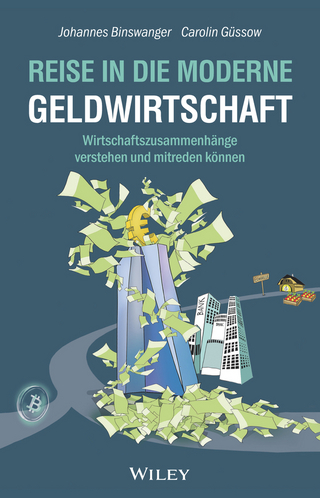
Selected Works of Joseph E. Stiglitz
Oxford University Press (Verlag)
978-0-19-953372-5 (ISBN)
This is the third volume in a new, definitive, six-volume edition of the works of Joseph Stiglitz, one of today's most distinguished and controversial economists. Stiglitz was awarded the Nobel Prize in Economics in 2001 for his work on asymmetric information and is widely acknowledged as one of the pioneers in the field of modern information economics and more generally for his contributions to microeconomics.
Volume III contains a selection of Joseph E. Stiglitz's work on microeconomics. It questions well-established tenets, including many that are so fundamental they are almost taken for granted, covering basic concepts of risk and markets; the management of risk; the theory of the firm; the economics of organization; and theory of human behaviour. Stiglitz reflects on his work and the field more generally throughout the volume by including substantial original introductions to the Selected Works, the volume as a whole, and each part within the volume.
Joseph E. Stiglitz is University Professor at Columbia University. In 2001, he was awarded the Nobel Prize in economics, and he was a lead author of the 1995 Report of the Intergovernmental Panel on Climate Change, which shared the 2007 Nobel Peace Prize. Known for his pioneering work on asymmetric information, Stiglitz focuses on income distribution, risk, corporate governance, public policy, macroeconomics and globalization. In 2011, Time named Stiglitz one of the 100 most influential people in the world. During the Clinton administration, Stiglitz was a member of the Council of Economic Advisers (CEA) from 1993-95, and served as CEA chairman from 1995-97. He then became Chief Economist and Senior Vice-President of the World Bank from 1997-2000. Stiglitz is also currently the Chief Economist of the Roosevelt Institute, Co-President of the Initiative for Policy Dialogue, and the co-chair of the High-Level Expert Group on the Measurement of Economic Performance and Social Progress at the OECD.
Part I: Risk and Markets: Basic Concepts
Introduction to Part I
A. Foundations of Risk
Measuring Risk
1: Joseph E. Stiglitz and Michael Rothschild: Increasing Risk
2: Joseph E. Stiglitz and P. Diamond: Increases in Risk and in Risk Aversion
Risk with more than one commodity
3: Behavior toward Risk With Many Commodities
4: A Consumption Oriented Theory of the Demand for Financial Assets and the Term Structure of Interest Rates
B: Portfolio Theory
5: Joseph E. Stiglitz and D. Cass: The Structure of Investor Preferences and Asset Returns, and Separability in Portfolio Allocation: A Contribution to the Pure Theory of Mutual Funds
6: Joseph E. Stiglitz and D. Cass: Risk Aversion and Wealth Effects on Portfolios with Many Assets
Part II: Management of Risk
Introduction to Part II
A: Trade and Capital Market Liberalization
7: Joseph E. Stiglitz and P. Dasgupta: Tariffs Versus Quotas As Revenue Raising Devices Under Uncertainty
8: Joseph E. Stiglitz: Capital-Market Liberalization, Globalization and the IMF
B: Risk Sharing
9: Joseph E. Stiglitz: Risk and Global Economic Architecture: Why Full Financial Integration May be Undesirable
10: Joseph E. Stiglitz: Contagion, Liberalization, and the Optimal Structure of Globalization
11: Joseph E. Stiglitz, Stefano Battiston, Domenico Delli Gatti, Mauro Gallegati, and Bruce Greenwald: Liaisons Dangereuses: Increasing Connectivity, Risk Sharing, and Systemic Risk
12: Joseph E. Stiglitz, S. Battiston, D. Delli Gatti, M. Gallegati, and B. Greenwald: Default Cascades: When Does Risk Diversification Increase Stability?
C: Commodity Price Stabilization
13: Joseph E. Stiglitz and D. Newbery: Risk Aversion, Supply Response, and the Optimality of Random Prices: A Diagrammatic Analysis
14: Joseph E. Stiglitz: Optimal Commodity Stock-Piling Rules
D: Schochastic Capital Theory
15: Joseph E. Stiglitz, William A. Brock and Michael Rothschild: Stochastic Capital Theory
Part III: Theory of the Firm
Introduction to Part III
A: Corporate Finance
16: Joseph E. Stiglitz: A Re-Examination of the Modigliani-Miller Theorem
17: Joseph E. Stiglitz: On the Irrelevance of Corporate Financial Policy
B: Alternative Objectives of the Firm
18: Joseph E. Stiglitz and S. Grossman: On Value Maximization and Alternative Objectives of the Firm
19: Joseph E. Stiglitz and S. Grossman: Stockholder Unanimity in the Making of Production and Financial Decisions
20: Joseph E. Stiglitz and B. Greenwald: Asymmetric Information and the New Theory of the Firm: Financial Constraints and Risk Behavior
C: The Implications of Value Maximization
21: Joseph E. Stiglitz: On the Optimality of the Stock Market Allocation of Investment
22: Joseph E. Stiglitz: Some Aspects of the Pure Theory of Corporate Finance: Bankruptcies and Take-Overs
23: Joseph E. Stiglitz: Some Elementary Principles of Bankruptcy
Part IV: Industrial Organization
Introduction to Part IV
A: Monopolistic Competition
24: Joseph E. Stiglitz and A. Dixit: Monopolistic Competition and Optimal Product Diversity
25: Joseph E. Stiglitz: Towards a More General Theory of Monopolistic Competition
B: Potential Competition
26: Joseph E. Stiglitz: Potential Competition May Reduce Welfare
27: Joseph E. Stiglitz: Technological Change, Sunk Costs, and Competition
C: Vertical Constraints
28: Joseph E. Stiglitz and P. Rey: Vertical Restraints and Producers' Competition
29: Joseph E. Stiglitz and P. Rey: The Role of Exclusive Territories in Producers' Competition
Part V: The Economics of Organization
Introduction to Part V
30: Joseph E. Stiglitz and R. Sah: Human Fallibility and Economic Organization
31: Joseph E. Stiglitz and R. Sah: The Architecture of Economic Systems: Hierarchies and Polyarchies
32: Joseph E. Stiglitz and R. Sah: Committees, Hierarchies and Polyarchies
33: Joseph E. Stiglitz and R. Sah: Qualitative Properties of Profit-Maximizing K-out-of-N Systems Subject to Two Kinds of Failure
34: Joseph E. Stiglitz and R. Sah: The Quality of Managers in Centralized Versus Decentralized Organizations
35: Joseph E. Stiglitz: Incentives, Information and Organizational Design
Part VI: Theory of Consumer Behavior
Introduction to Part VI
36: Joseph E. Stiglitz: Toward a General Theory of Consumerism: Reflections on Keynes' Economic Possibilities for Our Grandchildren
37: Joseph E. Stiglitz and K. Hoff: Equilibrium Fictions: A Cognitive Approach to Societal Rigidity
38: Joseph E. Stiglitz and Karla Hoff: Striving for Balance in Economics: Towards a Theory of the Social Determination of Behavior
| Erscheinungsdatum | 14.08.2019 |
|---|---|
| Reihe/Serie | Selected Works of Joseph E. Stiglitz |
| Verlagsort | Oxford |
| Sprache | englisch |
| Maße | 175 x 257 mm |
| Gewicht | 1956 g |
| Themenwelt | Wirtschaft ► Volkswirtschaftslehre ► Mikroökonomie |
| ISBN-10 | 0-19-953372-5 / 0199533725 |
| ISBN-13 | 978-0-19-953372-5 / 9780199533725 |
| Zustand | Neuware |
| Haben Sie eine Frage zum Produkt? |
aus dem Bereich


